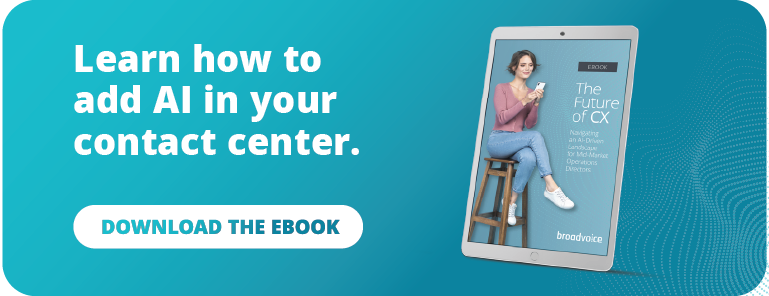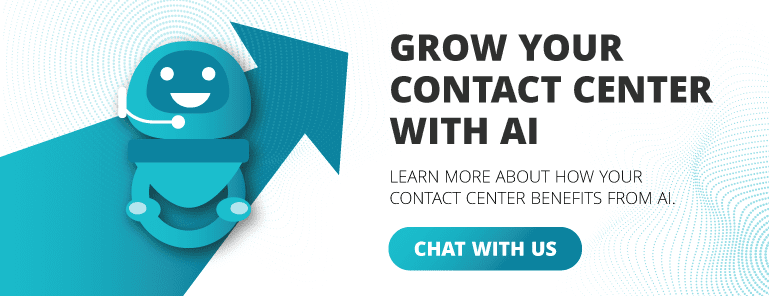Customer acquisition is expensive. In fact, it can cost up to 4 to 5x more to acquire new customers than retaining your current ones.
What’s more, companies that focus on retaining their existing customers reap wild benefits. Research shows that just a 5% increase in customer retention can lead to a 25% to 95% increase in profits. Clearly, there’s significant value in improving your customer experience.
And central to a good customer experience is your customer service. Salesforce found that 89% of consumers are more likely to return after a positive customer service experience. Yet, a recent survey shows Americans are more unhappy with customer service than ever. How do you fix that?
Driving good service starts by reducing friction. After all, even minor friction in the customer experience can leave customers with a bad perception of your brand.
So – how will you cut down on the effort or time your customers have to put forth to interact with you? How will you deliver a seamless experience across every channel and every touchpoint? That’s where omnichannel contact center software comes in. A frictionless CX is on the horizon. With this guide, we’ll help you build one.
Create a seamless contact center experience with this guide.
What is Omnichannel Contact Center Software?
Omnichannel contact center software is a solution that integrates all your communication channels and customer interactions into a seamless, unified experience.
No matter the channel your customers use to contact you – phone, email, chat, social media, or SMS – an omnichannel solution connects each channel without a hiccup. This lets customers contact you from one channel. Then, they can switch to another in the same interaction without repeating themselves. Customer service agents can also transfer customers to new channels or fellow agents and keep the customer’s complete history visible.
This is different, though, from a multichannel solution. The key difference lies in the integration. In a multichannel setup, each channel operates on its own. This often leads to disconnected customer experiences. Customers can reach out via any channel, but they can’t move between them. However, with an omnichannel solution, every channel is connected.
Let’s see how this makes a difference.
Without Omnichannel Service:
After detailing a customer service complaint to an agent, you sit on hold for 30 minutes, waiting to talk with their supervisor. Then, click, the call drops. For real? After punching in the number again, a new agent answers. They have no idea who you are, why you called earlier, or what you need. Frustrated, you hang up. Let’s try an email.
You start from square one. You have to describe your issue again and then proceed to wait four hours before getting a response. Even then, you have to send back-and-forth messages to the manager to clarify the situation and get the help you need. Not good.
With Omnichannel Service:
Now, imagine the same scenario, but this time, with an omnichannel solution. You call into customer service. The agent needs to escalate your issue to their supervisor. But, instead of having you wait on hold, they tell you to hang up and shift the issue to an email thread by simply sharing your ticket number. There’s no need to repeat yourself. You just send in the ticket number. Within an hour, the supervisor, who already has the full context of your issue, contacts you and resolves the issue immediately.
Talk about seamless. Let’s see why that matters.
Unlock the secret to exceptional CX with these latest contact center automation trends.
Key Benefits of Omnichannel Contact Center Software
Businesses that implement omnichannel contact center software experience several key benefits. Here are just a few.
1. Unified Customer Interactions
Omnichannel contact centers ensure that customer interactions are connected and coherent regardless of the channel. This reduces the likelihood of inaccuracies. And it improves CX, ensuring customers don’t need to repeat themselves to reach a resolution.
2. Enhanced Agent Productivity
With a single view of the customer’s journey, agents can access essential information. Better info allows them to provide faster and more accurate resolutions. Productivity gets a boost and average handle times drop.
3. Data-Driven Insights
Up to 72% of companies believe they can use analytics reports to improve the customer experience. But you need access to the full picture of the data to do so. Omnichannel software unifies customer interactions. So, your team gets access to that rich, real-time data. With clearer insight into your customers’ journey, you can make better decisions, strategies, and improvements.
4. Cost Efficiency
Omnichannel solutions cut out the need for separate systems for each communication channel. By combining all the tools you need in one software platform, omnichannel contact center software helps streamline operations, reduce inefficiencies, and lower operational costs.
But beyond these perks for your team, omnichannel service ultimately fosters a better customer experience – the biggest benefit of all.
Why Omnichannel Wins Over Your Customers
Your customers, whether they know it or not, love omnichannel service. Here’s why:
- It creates frictionless interactions. Customers can pick any preferred channel. Then, they can move between them without interrupting their experience.
- It enables personalized experiences. Omnichannel platforms allow businesses to track the entire customer journey. This lets agents tailor their interactions based on the customer’s history and preferences.
- It drives faster resolutions. With all customer data available, agents can easily access the information they need to resolve issues. This leads to faster resolution times and higher customer satisfaction.
Do You Need Omnichannel Contact Center Software?
Maybe you see all the benefits but are still not convinced. I get it. Investing in new software is no small initiative, after all. But your customers and your contact center operations could be screaming for change. Here are a few critical signs that your team needs to make the switch to omnichannel contact center software.
- You’re delivering fragmented customer experiences. Are your customers showing consistent frustration in their CSAT surveys? Are they often annoyed by having to repeat themselves across channels?
- You have disparate systems creating inefficiency and confusion. With customer interaction data flowing from separate tools and communication channels, is your team experiencing frequent miscommunication?
- Operational costs are on the rise. Are operations getting expensive managing multiple systems and teams for different channels?
- Reporting is inconsistent. Do you struggle to get a complete picture of your customer service performance?
If the answer is “yes” to more than one of the above questions, it’s time to get on board the omnichannel train. Let’s see what features could help you clean up your customer experience.
Discover the power of AI for better call center operations. Read more here.
Essential Features to Look for in Omnichannel Contact Center Software
1. A Unified Interface and Customer Data Management
Look for software that integrates customer data from all channels into one centralized platform. A unified cloud-based interface simplifies work for your agents. With a single interface, agents can access a complete view of customer history during interactions.
2. Seamless Channel Integration
Omnichannel software needs to integrate everything. That means it should connect with all of your existing platforms. It should also support a wide range of communication channels like voice, email, chat, social media, SMS, and even video. Look for a system that can show the entire conversion in a single thread, no matter the channel.
3. AI and Automation
AI is hot right now. And it’s not going anywhere. Opt for omnichannel contact center software with AI features like chatbots, virtual assistants, and automated workflows. Add features like AI sentiment analysis and agent assist tools to boost customer personalization. These added tools will help you to reduce repetitive tasks and boost CX.
Find the right AI tools for your team. Here are 5 signs the tools you’re adding actually help your agents.
4. Intelligent Routing
Omnichannel solutions need effective routing strategies to work. Look for intelligent routing capabilities. Features like interactive, AI-backed IVRs and skills-based routing can direct customers to the right answers from an agent, AI, or department based on their needs, previous interactions, or issue complexity.
5. Reporting and Analytics
Find a platform with comprehensive and consolidated real-time reporting and analytics. Reporting tools are essential for monitoring the performance of your contact center. With these tools, you can quickly identify areas for improvement. Look for a platform that offers customizable reports and dashboards so you can stay at the top of your game.
6. Scalability
As your business grows, your omnichannel contact center software should scale with it. Ensure that your chosen platform can accommodate increased volume and new communication channels.
Top Omnichannel Contact Center Providers to Explore
With your wish list in hand, here are a few top omnichannel contact center providers worth investigating.
1. Broadvoice
Broadvoice provides enterprise-level features for businesses of every size, helping you optimize customer interactions. The AI-driven omnichannel platform offers powerful automation and seamless integrations that make it easy to optimize and personalize every interaction.
Key features include omnichannel and intelligent routing, real-time reporting and analytics, workforce management, and the latest AI technology. Create customer-centric interactions with Broadvoice and elevate your omnichannel customer experience.
2. Five9
Five9, known for its scalability, offers omnichannel solutions that can handle high volumes. Five9’s key features include intelligent virtual agents, summarization tools, and analytical capabilities.
3. RingCentral
RingCentral is great for businesses of all sizes seeking a comprehensive UCaaS solution. Its key features include omnichannel communication, team messaging, video conferencing, and call recording with transcription.
4. Talkdesk
Talkdesk is a cloud-based contact center platform that offers a flexible and intuitive omnichannel platform. Its key features include omnichannel routing, automation tools, real-time and historical analytics, and workforce management. The feature-rich solution offers scalability and strong reporting and analytics. Though it comes at a higher price.
5. NICE
NICE is ideal for large enterprise businesses with a high call volume. The platform provides robust omnichannel routing, automation tools, and comprehensive reporting and analytics. NICE makes it particularly easy to track performance across all channels.
Find out more about Broadvoice’s omnichannel solution here.
Best Practices for Creating a Seamless Omnichannel Experience
Are you ready to take the leap? Here are a few key best practices to remember as you implement your omnichannel solution.
1. Take Note of Your Business Needs
No two companies are the same. Different businesses have different needs and gaps to fill in their service. Before implementing new software, ensure you assess what your team and service level require. Evaluate your customer volume, channel preferences, process gaps, and performance issues to understand how an omnichannel strategy can help.
2. Involve Key Stakeholders
Get all key stakeholders involved early to avoid data silos and miscommunication. An omnichannel contact center is costly, and it impacts different departments – including customer service, IT, and operations. Ensure you pick a solution that works for everyone across the organization by looping in decision-makers from each department.
3. Test the Software
Don’t skimp on research. Before you commit to a vendor, take advantage of free trials and demos to test how the software performs in real-world scenarios. Come prepared with a robust RFI. Ask if you can try out the platform yourself. And ensure your chosen platform is user-friendly for both agents and customers.
4. Assess Your Customer Journeys
Adding an omnichannel contact center software into your stack should be all about your customers. As you begin implementing an omnichannel strategy, start by mapping out your current customer journeys. Understand where your customers interact with your business and identify the most critical touchpoints. Then, build your channel and routing strategies to meet the needs and habits of your customers.
5. Prioritize Training
Introducing new technologies can be challenging for customer service teams. Take time to provide extensive and frequent training with your team. Change management will only happen if you ensure that agents are comfortable using omnichannel tools and understand how to use customer data to enhance interactions.
6. Be Aware of Common Challenges with Omnichannel Service
Remain cognizant of the common pitfalls of omnichannel service. Here are a few key challenges you’ll want to avoid:
- Data fragmentation. Ensure that your systems are fully integrated to prevent data silos.
- An imbalance of automation and the human touch. While automation is key to efficiency, customers still value human interactions, particularly for complex issues. Don’t overload your interaction with AI and automation. Instead, listen closely to customer feedback to know when the human touch is necessary.
- Losing sight of your customers. Flashy new tech is exciting. But you don’t want it to come at the expense of your customers. Keep your customers and their voices central at every step of the implementation and adoption process. Carefully watch your satisfaction and service levels to maintain excellent customer service.













